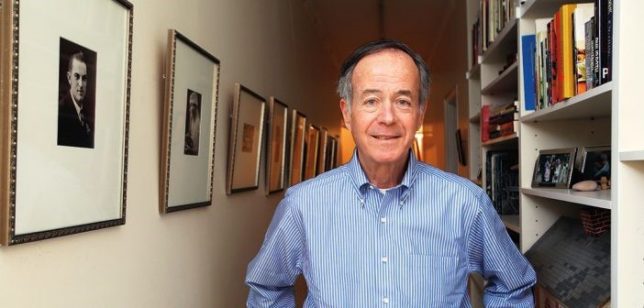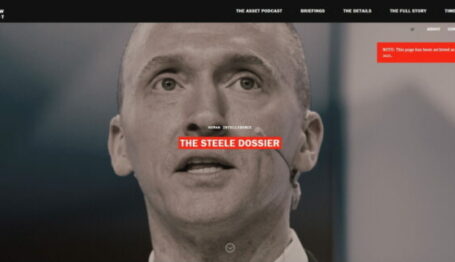Deception & Misdirection
The Left’s “Dark Money” Coordinator: Just Passing Through
 Donald Ross co-crafted the PIRG model alongside Nader in their 1971 book, Action for a Change, a sort of “how-to” manual for what would become the PIRG network.
Donald Ross co-crafted the PIRG model alongside Nader in their 1971 book, Action for a Change, a sort of “how-to” manual for what would become the PIRG network.

The Left’s “Dark Money” Coordinator (full series)
A Financial Clearinghouse | Just Passing Through | Funding “Civic Engagement” | Eyes on 2020
Summary: NEO Philanthropy is one of the Left’s best-kept “dark money” secrets. Commanding hundreds of millions of dollars, the group plays a key role in “incubating” dozens of new activist groups and coordinating left-wing efforts to alter the landscape of American politics in the 2020 census.
The NEO Model
Little is known about what kind of projects NEO Philanthropy sponsored in its early days, but according to Michele Lord it was always intended to serve as an incubator for other left-wing groups that weren’t prepared to pursue tax-exempt nonprofit recognition by the IRS. In Lord’s words, NEO was “the backroom for lots of organizations that didn’t have their own 501(c)(3) [status].”
From 1983 until the 2000s, NEO Philanthropy (or Public Interest Projects, as it was then known) was a relatively modest operation. In 2001, for example, the group reported revenues of $3.8 million; but in 2017, that figure was $45 million, an increase of roughly 1,400 percent in just 16 years.
Around 2008, NEO Philanthropy adopted its current name in a larger effort to rebrand itself as a key part of the institutional Left. Along with the name change came a substantial shift toward “alliance building” with major foundations, namely the Carnegie Corporation of New York and Ford, Knight, Mertz Gilmore, and Open Society Foundations. These and other grantmakers would provide continual funding to dozens of “fiscally sponsored projects” all hosted by NEO Philanthropy.
Now in its prime, NEO Philanthropy fulfills two key roles as part of the institutional Left: as a pass-through organization, moving millions of dollars each year to activist nonprofits from left-wing mega-funders; and as a fiscal sponsor or “incubator,” generating dozens of new groups which live under the NEO aegis.
NEO as a “Dark Money” Pass-Through
Unlike most major funders such as the Rockefeller and MacArthur Foundations, NEO Philanthropy doesn’t generate most of its money. Although a minority of its annual revenues every year come from investment- and program-related income, the vast majority of NEO’s funding originates as grants from major grantmakers on the Left.
NEO’s largest funders are private foundations, including the Carnegie Corporation of New York, the Evelyn & Walter Haas Jr. Fund, George Soros’s Foundation to Promote Open Society, Unbound Philanthropy, and the Ford, JPB, MacArthur, Bauman, Tides, W.K. Kellogg, Susan Thompson Buffett, and Mertz Gilmore Foundations.
Between 2010 and 2017 (the latest available year), NEO Philanthropy reported a staggering $337.8 million in revenues and $314 million in expenditures. It’s growing rapidly, too. In 2007, for instance, NEO reported earning $23 million; a decade later in 2017, that figure had grown to over $58 million, an increase of nearly 150 percent.
Moving tens of millions of dollars each year makes NEO an effective pass-through organization able to mask the flow of cash from major foundations to the hundreds of think tanks, legal nonprofits, and activist groups NEO supports.
Strictly speaking, the loosely defined term “dark money” typically applies to 501(c)(4) nonprofits which aren’t required to disclose their donors. But because NEO Philanthropy and the NEO Philanthropy Action Fund work in tandem, NEO itself might be described as “dark money-esque.” (It’s worth noting that the IRS requires 501(c)(3) public charities like NEO Philanthropy to disclose grants, though they may withhold the names of their grantors.)
The NEO Philanthropy Action Fund, however, is a more classic example of a “dark money” funder. Like it’s 501(c)(3) sibling, the 501(c)(4) Action Fund is a pass-through for other left-wing nonprofits, particularly for environmentalist groups. The Action Fund is significantly smaller than NEO Philanthropy, though, reporting $10 million in 2017 revenues compared with its sibling’s more robust $58 million.
As a 501(c)(4) nonprofit, the Action Fund isn’t required to disclose its donors, obscuring the source of much of its funding—hence the “dark money” designation. Discovering its donors is consequently difficult.
However, it’s clear that the Action Fund has received significant funding—nearly $22 million between 2009 and 2010, in fact—from Atlantic Philanthropies, the Bermuda-based foundation known for funding massive 501(c)(4) “dark money” operations in the United States. Because Atlantic Philanthropies isn’t U.S.-based, it isn’t required to file annual reports with the IRS, nor is it subject to the usual restrictions American foundations face in granting to 501(c)(4) lobbying groups.
And that’s critical to Atlantic Philanthropies, which famously moved $50 million to the vaguely named Civic Participation Action Fund in 2016 to help Hillary Clinton’s presidential campaign. In 2010, Atlantic Philanthropies funneled over $47 million to Health Care for America Now, a “dark money” lobbying group created by the Left to push the passage of Obamacare through Congress. (Also worth noting is Atlantic Philanthropies’ former president, Gara LaMarche, who is now president of the Democracy Alliance, a high-level funding coordination network associated with NEO Philanthropy.)
While information on NEO Philanthropy Action Fund’s donors are scarce, it does report its grant recipients—most notably the League of Conservation Voters, Environmental Defense Action Fund, Planned Parenthood, For Our Future Action Fund, Tom Steyer’s NextGen Climate Action, American Bridge 21st Century, Environment America, and the Sierra Club.
NEO as an Incubator
But not all grants to NEO Philanthropy pass through the organization. Many of them are used to finance NEO’s own fiscally sponsored projects.
So what is fiscal sponsorship? Under IRS rules, nonprofits are allowed to provide practical support to other nonprofits, paying for administrative services or managing their annual financial reports, usually in exchange for a small cut of earmarked donations. This kind of sponsorship is best applied to new startups which lack the resources to manage their operations themselves.
NEO Philanthropy, however, practices a different kind of fiscal sponsorship known as “incubation.” Under the NEO model, new groups are incubated that live and operate under the umbrella of its 501(c)(3) nonprofit status while awaiting their own nonprofit determination letter from the IRS—a process that can take months. The incubated group is treated as a “project” or “program” of NEO Philanthropy until it’s eventually spun-off as a standalone nonprofit.
Fiscal sponsorship is a common practice among nonprofits on the Left and the Right since it’s an efficient way to create new organizations, and many funders provide limited fiscal sponsorship services. The donor-advised fund provider DonorsTrust, for instance, has helped develop a number of conservative and Christian nonprofits.
But unlike DonorsTrust, incubation is NEO Philanthropy’s bread and butter. Michele Lord herself has called NEO a “bridge” between activists and grantmakers, providing both with numerous groups to push a left-wing agenda.
It’s important to recognize that NEO’s dual roles as a pass-through funder and an incubator are complementary and related. Many of the grants given to NEO are made in support of its projects. You can think of it as a kind of nonprofit startup service: give NEO the cash and it’ll incubate a project of your choice, complete with staff, a website, and office space in its New York headquarters. And depending upon the client’s intent, that startup may or may not grow into a fully-fledged nonprofit.
At the same time, NEO often makes grants to activist groups and think tanks through three grantmaking “Funds,” which are explored in detail below. Think of these three Funds as line-items on NEO’s budget—ways to delineate how the “dark money” from NEO’s mega-funders is distributed to the hundreds of organizations it supports.
While no exhaustive list of its projects exists, NEO currently hosts some 60 such projects, according to its website. To date, CRC has identified over half of them.
Some of NEO’s past projects are now independent nonprofits, like Define American, which advocates for a path to citizenship for immigrants living in the U.S. illegally. Similarly, the environmentalist media website InsideClimate News began life in 2007 as a NEO project; in 2014, it “detached from its fiscal sponsor” to become a standalone 501(c)(3) nonprofit.
Complementing this incubation work is the NEO Philanthropy Action Fund, the group’s 501(c)(4) lobbying arm. Like other incubation groups, the Action Fund is NEO Philanthropy’s “little sister,” hosting the “advocacy” arms of a number of NEO Philanthropy’s projects to form a 501(c)(3)-501(c)(4) pair. For example, MPower Change is an Islamic immigration advocacy group created by radical activist Linda Sarsour in 2016. It’s also a project of NEO Philanthropy, while the group’s advocacy arm, MPower Change Action, is hosted by NEO Philanthropy Action Fund.
Why host two related projects? Splitting the pair allows each to maximize the advantages of NEO Philanthropy’s 501(c)(3) status and NEO Philanthropy Action Fund’s 501(c)(4) status: donations to the former are tax-deductible for donors, while the latter can spend a higher percentage of its funds on lobbying. And because MPower Change and MPower Change Action are projects, not standalone nonprofits, their budgets are effectively invisible—drops in the vast ocean that is NEO’s budget.
The NEO model means it can host dozens of projects without ever revealing exactly how much it spends on each project, or which of its numerous donors funded which project.
In the next installment of The Left’s “Dark Money” Coordinator, learn about a few of the big-budget projects NEO helps support



